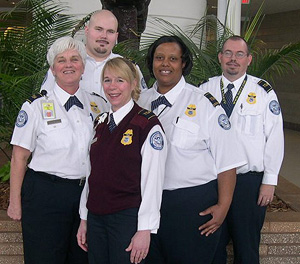Training is the Cornerstone of TSA's Security Operations
Join Us
July 22, 2008
 In recent months you may have noticed that TSA officers are more engaged with passengers, starting with the travel document checker who represents just one of many layers of security protecting air travelers from a terrorist act.
In recent months you may have noticed that TSA officers are more engaged with passengers, starting with the travel document checker who represents just one of many layers of security protecting air travelers from a terrorist act.
These specially trained security officers are illustrative of TSA's ongoing efforts to field a highly skilled, highly trained and professional workforce that is second to none in aviation security.
That impressive performance puts our transportation security officers – TSOs – in demand for jobs throughout the Department of Homeland Security, from the Federal Air Marshal Service to Customs and Border Protection.
And screening more than 2 million people every day hones skill that TSOs use to reliably intercept firearms, drugs, people traveling with fraudulent documents, and other prohibited items like throwing stars and brass knuckles, some of them artfully concealed.
Training runs the gamut from technology – including the X-ray and explosives detection machines at security checkpoints – to baggage screening and behavior detection officers who can be anywhere at the airport – watching for tell-tale behavior indicating a threat. Officers are also trained to work and communicate with people of diverse backgrounds, sometimes in a stressful environment.
A TSO's initial training consists of 180 hours, 115 of which are on the job. After training, there is retraining that, as TSA Administrator Kip Hawley told the House Committee on Homeland Security, will "make security smarter and harder to beat."
That continued training includes 22 hours quarterly for each TSO. In addition, nearly 3,000 improvised explosive device (IED) drills are conducted at checkpoints across the country every day. Also every day, more than 85,000 images of dangerous and prohibited items are projected onto X-ray screens during checkpoint operations, further honing the TSOs' X-ray skills. That's just about one test occurring every second of every day around the country.
This is training that works. In Pittsburgh, a TSO in her second day of on-the-job training was operating the X-ray for the first time. In the third bag to go through she spotted a .22-caliber handgun and two loaded ammunition clips.
And in Orlando this spring, a passenger's suspicious actions caught the attention of one of our behavior detection specialists. The traveler's checked baggage was intercepted before it went to screening. Searching his bags, officers found everything needed to build a bomb.
Delivering security is not a job of rote. Delivering security requires a workforce that thinks on its collective feet, anticipating threats and reacting quickly. As Hawley told the committee, "It is not about completing a checklist. It is about stopping terrorist plots."

